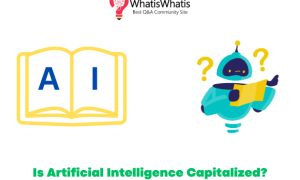What is the history of Artificial Intelligence (AI)?
Artificial intelligence is a topic that has been around since the 1950s, but what does it mean? Artificial Intelligence is a field of computer science and an engineering discipline that focuses on developing intelligent machines with human-level understanding. It is not just about making computers more powerful or faster. Rather, AI tries to make sense of data to learn from it and accomplish tasks.
The history of AI spans back to ancient Greek civilization when philosophers came up with the idea of artificial beings who could reason through language problems. More recently, in 1956, two scientists at Dartmouth College created one of the first mathematical theories for how you could teach an artificial being by “teaching” it new information, much like humans are taught in school.
Know more: Why Is Everyone Talking About B Tech Artificial intelligence?
Have you ever wondered what Artificial Intelligence is?
Well, wonder no more! We’re here to tell you all about it. Artificial intelligence is a broad concept that deals with creating intelligent machines and software that can perform tasks normally requiring human intelligence. It’s an exciting field of study, and there are many different applications for AI in our lives today.
For example, did you know that Google uses artificial intelligence to help identify objects in images? Or how about Siri – she uses artificial intelligence to understand your voice commands! And if you have a smart home device like Amazon Echo or Google Home, those devices use artificial intelligence as well! There are so many ways we interact with this technology every day without even realizing it. So let us be your guide on this journey into the world of AI comes. You won’t regret it!
Before the term “Artificial Intelligence” was coined in 1956, several project proposals would now be considered AI. These include:
The first actual AI program is also one of the oldest software programs ever written and is called “Eliza,” which was developed by Joseph Weizenbaum in 1966. The goal of the program was to impersonate a Rogerian psychotherapist. It operates by deriving new responses based on user input patterns and some handcrafted rules. For example:
A user types in I am worried about my health
Eliza responds with: Why do you say you are worried about your health?
Around this time, John McCarthy develops many ideas in AI, including the first-ever AI conference in 1956.
The Dartmouth Conference is where the term “Artificial Intelligence” was coined and a set of 18 research problems in AI that still hold today. To know more check RemoteDBA.com. The researchers at this meeting coined many terms such as:
Progress History of Artificial Intelligence (AI):
Around 1974, parallel to the development of Expert Systems and Statistical Classification, Marvin Minsky and Seymour Papert start developing a new model of teaching called The Society of Mind. This model tries to explain how complex behaviors can come from simple interactions between more basic parts.
Know more: Automation and Artificial intelligence: Know How it Revolutionized the Way of Doing Business
In 1977, Minsky published Computation: Finite and Infinite Machines, which described finite state machines (FSMs), an important concept for understanding modern programming languages. In 1985, John Haugeland’s book, Artificial Intelligence: The Very Idea, is heavily critical of McCarthy’s “The Society of Mind” model.
In 1980, Eric Arthur Blair (better known as George Orwell) published his most famous novel Nineteen Eighty-Four. In this novel, the government has developed an almost perfect virtual world called “the party.” All citizens are forced to interact with and believe that a supercomputer named “Big Brother controls the virtual world. In 1984, Douglas Hofstadter’s book MetamagicalThemas focused on AI in Chapter 7, which he calls GOFAI or Good Old Fashioned AI. He describes it as using logic rules to make conclusions about data inputted into the computer.
In 1984, the long-running robotics journal Robotics Age was first published by David L. Heiserman and eventually becomes the official publication of The Robotics Institute (TRI), founded in 1979 as a division of Carnegie Mellon University.
During the 1990s, AI progressed in many areas such as search algorithms like A*, knowledge representation and discovery frameworks such as semantic nets or ontologies, planning algorithms like formal dynamic logic or STRIPS, machine learning algorithms like linear least squares regression or support vector machines, natural language processing (NLP) techniques such as hidden Markov models or singular value decomposition analysis, and computer vision with motion detection and object recognition allowing for visual perception. By the end of this decade, almost all AI projects are done as part of a more general discipline, such as computer science analytical tools or electrical engineering.
In 1990, Rodney Brooks published the subsumption architecture, which was very influential in future robotics. In 1992, Olaf Sporns described the human connectome.
In 1997, Chris Watkins and Raúl Arrabales published an article in IEEE Intelligent Systems called ” The Age of Spiritual Machines: When computers Exceed Human Intelligence. ” Along with this book is Ray Kurzweil’s most well-known book, The Singularity is Near, which predicts exponential growth in technology until reaching singularity sometime within the 21st century.
In 2001, Steve Omohundro’s paper on Basic AI Drives what he believes to be important for self-improving AI to have. In 2005, the University of Texas completed a robot with six legs called “Austin.”
In 2009, IBM’s computer Watson defeated two human contestants on the game show Jeopardy! It is a landmark event for AI because it shows that computers can perform well in areas previously thought only to be performed well by humans.
Learn more: The Future of Artificial intelligence: Edge Computing Systems
How is AI Evolving?
AI has been around for a long time. It’s not new, but it is evolving and maturing exponentially with the advent of deep learning neural networks. The future will be more automated than ever before, as we rely on artificial intelligence to take care of tasks too difficult or tedious for humans to complete efficiently.
Artificial intelligence is a broad term that covers many disparate fields of computer science, from expert systems to machine learning. Even though it’s been around for decades, AI is yet to deliver on the lofty expectations set by its pioneers.
Also Read: Ways Artificial Intelligence is Benefiting Small Businesses
We are changing all that with our new product! Our team of AI experts has created an artificial intelligence platform capable of revolutionizing your business processes and operations. With this easy-to-use solution, you can automate manual tasks and free up valuable time for more important things like innovation.
In the future, AI will become a part of our everyday lives. It’s important to understand just how far we have come in this field and where it is going so that you can use these technologies for your own business or personal needs.






Leave a comment